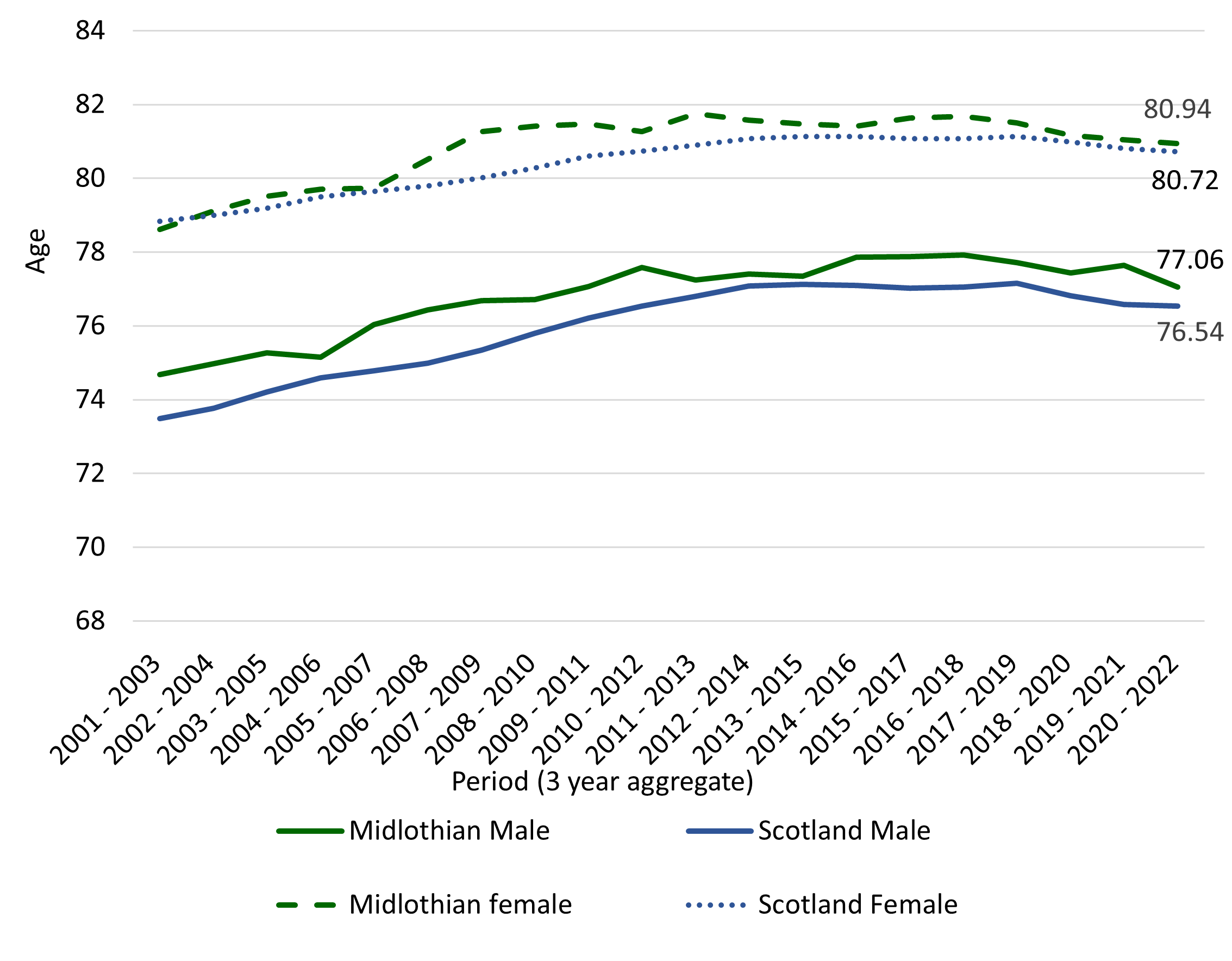Life Expectancy - Data
Life Expectancy is an estimate of the number of years a new-born child would live if it were to experience the current mortality rate for all its life. It is a measure of the overall health of a population and how well society is doing.
Scotland has one of the lowest life expectancies in Western Europe and it is getting worse for the least well off (McCartney et al., 2022). Nationally, life expectancy is used to assess and set several important policies that impact on everyday life such as the process for setting the State Pension Age.
The life expectancy at birth in Midlothian is slightly above the Scottish average (2019/21) for both males and females.
Women’s overall life expectancy is higher than men’s in Midlothian. However, there are stark differences in health because of poverty and social disadvantage. Life expectancy varies by up to 10 years across different parts of Midlothian (National Records Scotland,2023).
Life expectancy in Midlothian and Scotland by age and sex 2001-2003 to 2019-2021
Data source: National Records of Scotland

Healthy Life expectancy
Healthy life expectancy is the average number of years that a new-born can expect to live in “full health.” Life expectancy is an important indicator to gauge the overall health of a community's health and can be used locally to assess inequality between different population groups.
Locally the gap between life expectancy and healthy life expectancy has increased by 0.9 years for both men and women since the last Joint Needs Assessment data was collated in 2019. This mirrors the national trend (National Records for Scotland, 2023).
Although there is a large gap between male and female life expectancy in both Midlothian and Scotland the same is not true for healthy life expectancy, where there is less difference between genders.
Female and male life and healthy life expectancy at birth in years for 2019-2021
Data source: National Records of Scotland
Mortality
It is important to monitor the number of deaths (mortality) observed in an area over a specified time. These are best compared as rates per 100,000 population, age-standardised to take account of differences in the structure of the population so that we are comparing like with like. For instance, one area might have a lower death rate than another simply because the proportion of younger people living there is higher than the second area. Age-standardisation takes account of these differences between areas.
We expect to see a relationship between the relative socioeconomic deprivation of an area and the mortality rate, with the most deprived areas having the highest mortality rate. This relationship is found in Midlothian.
Early deaths (premature mortality)
If someone dies aged less than 75 years this is considered to be an early or premature death and potentially preventable. Early mortality rates are the number of deaths of people under 75 observed over a specified time. These are a subset of the overall death rate. These are best compared as rates per 100,000 population, standardised to take account of differences in the structure of the populations being compared.
Avoidable mortality
Avoidable Mortality is deaths under the age of 75 which are considered either preventable or treatable through public health interventions or timely and effective healthcare. This is a subset of early mortality and is based on an international definition by the OECD/Eurostat (National Records Scotland, 2023). Midlothian has the second highest avoidable mortality rate in the Lothians, with West Lothian being the highest and East Lothian being the lowest.
Avoidable mortality rates, all persons 2019-2021 Average
Data source: National Records Scotland

Page updated: February 2025
